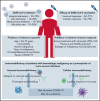COVID-19 in patients with hematologic malignancy
- PMID: 35544585
- PMCID: PMC9098396
- DOI: 10.1182/blood.2021012251
COVID-19 in patients with hematologic malignancy
Abstract
The coronavirus infectious disease (COVID-19) shows a remarkable symptomatic heterogeneity. Several risk factors including advanced age, previous illnesses, and a compromised immune system contribute to an unfavorable outcome. In patients with hematologic malignancy, the immune response to severe acute respiratory syndrome coronavirus 2 (SARS-CoV-2) is significantly reduced explaining why the mortality rate of hematologic patients hospitalized for a SARS-CoV-2 infection is about 34%. Active immunization is an essential pillar to prevent SARS-CoV-2 infections in patients with hematologic malignancy. However, the immune response to SARS-CoV-2 vaccines may be significantly impaired, as only half of patients with hematologic malignancy develop a measurable antiviral antibody response. The subtype of hematologic malignancy and B cell-depleting treatment predict a poor immune response to vaccination. Recently, antiviral drugs and monoclonal antibodies for pre-exposure or postexposure prophylaxis and for early treatment of COVID-19 have become available. These therapies should be offered to patients at high risk for severe COVID-19 and vaccine nonresponders. Importantly, as the virus evolves, some therapies may lose their clinical efficacy against new variants. Therefore, the ongoing pandemic will remain a major challenge for patients with hematologic malignancy and their caregivers who need to constantly monitor the scientific progress in this area.
© 2022 by The American Society of Hematology.
Figures
References
-
- Volz E, Mishra S, Chand M, et al. ; COVID-19 Genomics UK (COG-UK) consortium . Assessing transmissibility of SARS-CoV-2 lineage B.1.1.7 in England. Nature. 2021;593(7858):266-269. - PubMed
MeSH terms
Substances
LinkOut - more resources
Full Text Sources
Medical
Miscellaneous



